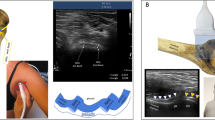Abstract
Introduction
Secondary cuff failure after shoulder replacement is disabling and often requires additional surgery. Increased critical shoulder angle (CSA) has been found in patients with cuff tear compared to normal subjects. The interobserver reliability of the CSA and the relationship between CSA and symptomatic secondary cuff failure after shoulder replacement were investigated.
Materials and methods
Nineteen patients with symptomatic cuff failure after anatomic shoulder replacement (mean FU 45 months) were compared to a control group of 29 patients showing no signs of symptomatic cuff failure (mean FU 105.7 months). The CSA was measured by two blinded surgeons at a mean follow-up of 45 and 105.7 months, respectively. Inter-observer reliability was calculated.
Results
The mean CSA in the study group in neutral, internal and external rotations were 33°, 34° and 34°, respectively. Corresponding values in the control group were 32°, 32° and 32°. The interclass correlation coefficient for the whole population between the two examiners were 0.956 (P < 0.01), 0.964 (P < 0.01) and 0.955 (P < 0.01), respectively.
Conclusion
There were no significant differences of CSA values between patients who had undergone shoulder replacement and experienced late cuff failure and those in whom the same procedure had been successful. A good inter-observer reliability was found for the CSA method.

Similar content being viewed by others
References
Leschinger T, Raiss P, Loew M, Zeifang F (2017) Predictors of medium-term clinical outcomes after total shoulder arthroplasty. Arch Orthop Trauma Surg 137(2):187–193. doi:10.1007/s00402-016-2602-x
Bohsali KI, Wirth MA, Rockwood CA Jr (2006) Complications of total shoulder arthroplasty. J Bone Joint Surg Am 88(10):2279–2292. doi:10.2106/jbjs.f.00125
Chin PY, Sperling JW, Cofield RH, Schleck C (2006) Complications of total shoulder arthroplasty: are they fewer or different? J Shoulder Elbow Surg Am Shoulder Elbow Surg 15(1):19–22. doi:10.1016/j.jse.2005.05.005
Young AA, Walch G, Pape G, Gohlke F, Favard L (2012) Secondary rotator cuff dysfunction following total shoulder arthroplasty for primary glenohumeral osteoarthritis: results of a multicenter study with more than five years of follow-up. J Bone Joint Surg Am 94(8):685–693. doi:10.2106/jbjs.j.00727
Cofield RH, Edgerton BC (1990) Total shoulder arthroplasty: complications and revision surgery. Instr Course Lect 39:449–462
Hattrup SJ, Cofield RH, Cha SS (2006) Rotator cuff repair after shoulder replacement. J Shoulder Elbow Surg Am Shoulder Elbow Surg 15(1):78–83. doi:10.1016/j.jse.2005.06.002
Bigliani ULMD, April EW (1986) The morphology of the acromion and its relationship to rotator cuff tears. Orthop Trans 10:228
Hughes RE, Bryant CR, Hall JM, Wening J, Huston LJ, Kuhn JE, Carpenter JE, Blasier RB (2003) Glenoid inclination is associated with full-thickness rotator cuff tears. Clin Orthop Relat Res 407:86–91
Tetreault P, Krueger A, Zurakowski D, Gerber C (2004) Glenoid version and rotator cuff tears. J Orthop Res Off Publ Orthop Res Soc 22(1):202–207. doi:10.1016/s0736-0266(03)00116-5
Nyffeler RW, Werner CM, Sukthankar A, Schmid MR, Gerber C (2006) Association of a large lateral extension of the acromion with rotator cuff tears. J Bone Joint Surg Am 88(4):800–805. doi:10.2106/jbjs.d.03042
Moor BK, Bouaicha S, Rothenfluh DA, Sukthankar A, Gerber C (2013) Is there an association between the individual anatomy of the scapula and the development of rotator cuff tears or osteoarthritis of the glenohumeral joint?: a radiological study of the critical shoulder angle. Bone Joint J 95(7):935–941. doi:10.1302/0301-620x.95b7.31028
Moor BK, Wieser K, Slankamenac K, Gerber C, Bouaicha S (2014) Relationship of individual scapular anatomy and degenerative rotator cuff tears. J Shoulder Elbow Surg Am Shoulder Elbow Surg 23(4):536–541. doi:10.1016/j.jse.2013.11.008
Rosset A, Spadola L, Ratib O (2004) OsiriX: an open-source software for navigating in multidimensional DICOM images. J Digit Imaging 17(3):205–216. doi:10.1007/s10278-004-1014-6
Petri M, Euler SA, Dornan GJ, Greenspoon JA, Horan MP, Katthagen JC, Millett PJ (2016) Predictors for satisfaction after anatomic total shoulder arthroplasty for idiopathic glenohumeral osteoarthritis. Arch Orthop Trauma Surg 136(6):755–762. doi:10.1007/s00402-016-2452-6
Randelli P, Randelli F, Compagnoni R, Cabitza P, Ragone V, Pulici L, Banfi G (2015) Revision reverse shoulder arthroplasty in failed shoulder arthroplasties for rotator cuff deficiency. Joints 3(1):31–37
Jacxsens M, Walz T, Durchholz H, Muller AM, Flury M, Schwyzer HK, Audige L (2017) Towards standardised definitions of shoulder arthroplasty complications: a systematic review of terms and definitions. Arch Orthop Trauma Surg 137(3):347–355. doi:10.1007/s00402-017-2635-9
Wirth MA, Rockwood CA Jr (1996) Complications of total shoulder-replacement arthroplasty. J Bone Joint Surg Am 78(4):603–616
Cofield RH (1996) Revision procedures for shoulder arthroplasty. In: Morrey BF (ed) Reconstructive surgery of the joints, vol 1. Churchill Livingstone, New York, pp 789–799
Miller BS, Joseph TA, Noonan TJ, Horan MP, Hawkins RJ (2005) Rupture of the subscapularis tendon after shoulder arthroplasty: diagnosis, treatment, and outcome. J Shoulder Elbow Surg Am Shoulder Elbow Surg 14(5):492–496. doi:10.1016/j.jse.2005.02.013
Suter T, Gerber Popp A, Zhang Y, Zhang C, Tashjian RZ, Henninger HB (2015) The influence of radiographic viewing perspective and demographics on the critical shoulder angle. J Shoulder Elbow Surg Am Shoulder Elbow Surg. doi:10.1016/j.jse.2014.10.021
Author information
Authors and Affiliations
Corresponding author
Ethics declarations
Conflict of interest
The authors declare that they have no conflict of interest.
Ethical standards
All procedures performed in studies involving human participants were in accordance with the ethical standards of the institutional and/or national research committee and with the 1964 Helsinki Declaration and its later amendments or comparable ethical standards.
Rights and permissions
About this article
Cite this article
Cerciello, S., Monk, A.P., Visonà, E. et al. The influence of critical shoulder angle on secondary rotator cuff insufficiency following shoulder arthroplasty. Arch Orthop Trauma Surg 137, 913–918 (2017). https://doi.org/10.1007/s00402-017-2707-x
Received:
Published:
Issue Date:
DOI: https://doi.org/10.1007/s00402-017-2707-x




